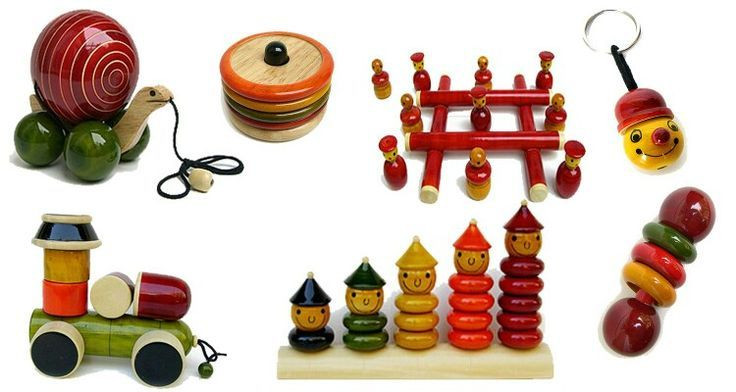- Dugg Duggi : Dugg Duggi is a type of rattle, mainly for infants and babies to attract their eyes and develop their sense of hearing through the jingling sound it makes. It resembles the instrument Damru played by Lord Shiva, which is vigorously shaken left and right to produce the sound.
Traditionally, it was made of wood and leather but nowadays paper is used. The paper is soaked in water to soften and then the core is formed which is later covered with paper and colour. A string is wrapped in the middle with two small balls tied at both ends. These balls, when shaken, hit the core to make the sound. - Dolls: India has a huge variety of traditional dolls. They come in different shapes, colours, made up of different materials, and so on. Traditional dolls of India can be classified into four major categories.
- Wooden Dolls: Most of the traditional dolls are made of wood. Almost every nook and corner of the country has a variety of wooden dolls. Some of the important wooden dolls are:
Channapatna dolls from Karnataka were primarily made of ivory wood but nowadays rosewood and sandalwood are also used. These dolls are very popular and have got the Geographical Indication Tag.
Wooden Dolls of Varanasi are brightly coloured lacquered toys of Uttar Pradesh. These dolls were previously made of ivory during the Mughal Period but now artisans use Keria and Eucalyptus wood to make them. They are later painted with lacquer by brushes made of squirrel's tail hair. These dolls have also got the Geographical Indication Tag.
Natungram Dolls of West Bengal has been very popular around the country with their signature wooden owl figurine. The woods of mainly Mango, Gamar, Shimul, and Chhatim are used by artisans for doll making. A unique feature is that the painting of the doll must be done by a female member which ensures the participation of women in the handicraft industry since medieval times.
Kondapalli Dolls: Originated over four centuries ago in Andhra Pradesh, Kondapalli dolls are renowned for their expressiveness. They are made of a softwood called Tella Poniki, they generally depict characters and stories from mythology, rural lives, birds, and animals. They are traditionally assembled in houses during Sankranti and Navratri festivals.
- Clay and Terracotta Dolls: There is a wide variety of clay dolls. Some of the important clay and terracotta dolls of India are:
Thanjavur Dolls of Tamil Nadu are examples of Bobblehead or Roly-poly dolls of India. These are terracotta dolls whose bottom-most part contains the center of gravity and the weight which generates a continuous dance-like movement with slow oscillations. These dolls have received the Geographical Indication Tag for their unique feature.
Asharikandi Terracotta Dolls from Assam are made extensively from Hiramati Clay and the artisans use very simple types of equipment like Kodal, knives, and sticks, and simple pottery techniques to create the figurines of deities, birds, animals, and objects from everyday life which reflects the societal customs of that area. 'Hatima Putul' is the most popular figurine of this craft.
Ghurni Clay Dolls which are also known as Krishnanagar Clay Dolls can mesmerize the beholder with their Realism. Made of a mixture of clay and bronze, these dolls are the finest examples of perfectionism of the craftsman who can make dolls resembling any living and non-living object with every minute detail. Ranging from common doll figures to popular comic characters these dolls have gained international appreciation.
- Cloth Dolls: Cloth dolls have existed in the world from the time of the emergence of cloth. It is the most common type of household doll making done by stitching pieces of cloth, rags, sequins, and buttons in the shape of a doll. This practice is prevalent in India and at present cloth doll making has been commercialized with trained artists. The Bengali Babu cloth doll is a popular example.
- Metal Dolls: Since the Indus Valley Civilization, metals like Copper and Bronze are shaped to produce toys. Metal toy making is still found in Uttar Pradesh, Gujarat, Tamil Nadu, and Andhra Pradesh. The metals are melted and poured on a clay mould prepared from wax models. Then the mould is broken and the figure is obtained. Dokra art is an example of metal doll making.
3. Puppets: India has a rich history of puppetry. Puppets are not just toys, but rather a means of storytelling to children. Puppets are made of cloth or wood with their limbs tied to strings which when pulled cause movement. Referred by various names like Kathputli, Putul Nach, etc across the country, the Raja Rani puppets of Rajasthan are at present the face of Indian puppetry. Puppet shows are still held and enjoyed by people of all age groups.
Picture Source: Pinterest



